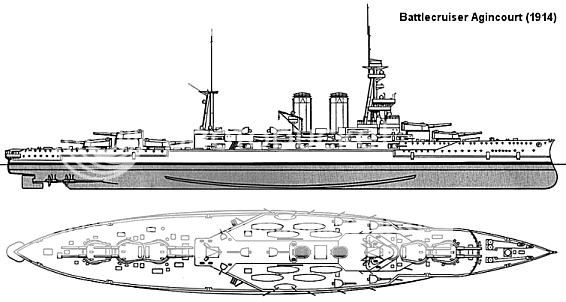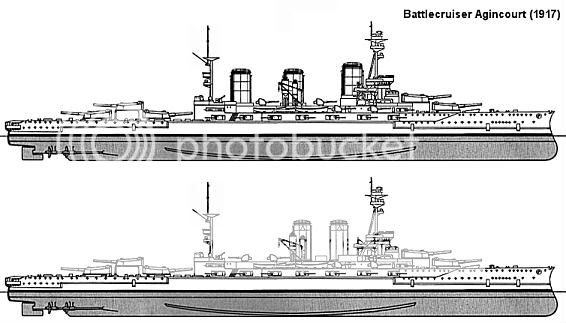In 1922, taking advantage of the Washington Naval Treaty Part 2 Paragraph II. (e), the Royal Navy took the opportunity to convert a single Capital Ship to the status of Experimental Training Ship, by rendering it unfit for warlike service, but allowing it to be used as a test bed for new experimental weaponry. Since the negotiating parties had been unable to agree on the weaponry limitations for this one-off exemption, (how can we prohibit what we have not yet invented, the parties argued) the Experimental Training Ship exemption placed no restrictions on weaponry, even caliber, but were required to remove the conning tower and all side armour, and machinery that would permit speed in excess of 18 knots.
The Admiralty chose HMS Agincourt for this role. The belt armour and conning tower were removed, and bulges were added to provide buoyancy and stability. It was thought that no boilers would have to be removed, as the installation of the bulges and new main battery would add sufficient weight to slow the ship to less than 18 knots.
Finally the Agincourt’s 14 BL 12 inch Mk XIII guns in seven twin turrets were replaced by seven turrets that had been constructed for the first three N3 battleships whose hulls had been required to be scrapped by the treaty. This upgraded Agincourt’s main armament to 21 BL 18 inch guns in seven triple turrets.
In order to accommodate the much larger turret rings without expensively rebuilding Agincourt right down to the keel, the roller path was constructed on a reinforced section of deck cantilevered out from the barbette, while the main trunk and hoists were restricted by the smaller diameter of the original barbette for the 12 inch guns. The resulting hoist system was not able to operate the same rate of fire, but this was considered acceptable for an experimental ship that would not see actual combat.
Negotiating the much larger turrets on deck took some modifications in layout. While A, P, Y and Z turrets retained their original traverse, the rear overhang of B turret filled the entire space the conning tower had previously occupied. Q turret and barbette were lowered to the main deck to reduce topweight, and to allow P turret’s barrels to swing over top. Q and X turrets were in the same locations, but with their longer barrels they could not rest on centerline, they needed to be trained 10 degrees to port or starboard. Training Q and X turrets to opposite broadside took some choreography. After P turret trained to one side, Q turret had to elevate the guns to maximum to swing the barrels over the P gunhouse roof. A similar maneuver was performed with X turret and the aft deckhouse.
All this chicanery produced a dreadnought that was capable of firing a 21 gun broadside, each barrel throwing a 2916 pound shell, for a total broadside of 61,236 lbs. In comparison, the next most powerful broadside in existence at the time belonged to the US Standard battleships of the Tennessee, New Mexico, and Pennsylvania classes at 18,000 lbs. The later Yamato class fired a broadside of only 28,971 lbs. The only competitor that approached Agincourt was the 57,942 lb. broadside of the Japanese battleship Hyuga, when she was fitted with the 6 turrets made surplus by the carrier conversion of Yamato sister Shinano and the cancellation of an unnamed 4th ship.
Apparently Agincourt’s decks became quite lively when firing full broadsides. One waggish officer remarked that when a full broadside was fired the resulting sheet of flame was big enough to create the impression that Krakatoa had blown up.
The Admiralty chose HMS Agincourt for this role. The belt armour and conning tower were removed, and bulges were added to provide buoyancy and stability. It was thought that no boilers would have to be removed, as the installation of the bulges and new main battery would add sufficient weight to slow the ship to less than 18 knots.
Finally the Agincourt’s 14 BL 12 inch Mk XIII guns in seven twin turrets were replaced by seven turrets that had been constructed for the first three N3 battleships whose hulls had been required to be scrapped by the treaty. This upgraded Agincourt’s main armament to 21 BL 18 inch guns in seven triple turrets.
In order to accommodate the much larger turret rings without expensively rebuilding Agincourt right down to the keel, the roller path was constructed on a reinforced section of deck cantilevered out from the barbette, while the main trunk and hoists were restricted by the smaller diameter of the original barbette for the 12 inch guns. The resulting hoist system was not able to operate the same rate of fire, but this was considered acceptable for an experimental ship that would not see actual combat.
Negotiating the much larger turrets on deck took some modifications in layout. While A, P, Y and Z turrets retained their original traverse, the rear overhang of B turret filled the entire space the conning tower had previously occupied. Q turret and barbette were lowered to the main deck to reduce topweight, and to allow P turret’s barrels to swing over top. Q and X turrets were in the same locations, but with their longer barrels they could not rest on centerline, they needed to be trained 10 degrees to port or starboard. Training Q and X turrets to opposite broadside took some choreography. After P turret trained to one side, Q turret had to elevate the guns to maximum to swing the barrels over the P gunhouse roof. A similar maneuver was performed with X turret and the aft deckhouse.
All this chicanery produced a dreadnought that was capable of firing a 21 gun broadside, each barrel throwing a 2916 pound shell, for a total broadside of 61,236 lbs. In comparison, the next most powerful broadside in existence at the time belonged to the US Standard battleships of the Tennessee, New Mexico, and Pennsylvania classes at 18,000 lbs. The later Yamato class fired a broadside of only 28,971 lbs. The only competitor that approached Agincourt was the 57,942 lb. broadside of the Japanese battleship Hyuga, when she was fitted with the 6 turrets made surplus by the carrier conversion of Yamato sister Shinano and the cancellation of an unnamed 4th ship.
Apparently Agincourt’s decks became quite lively when firing full broadsides. One waggish officer remarked that when a full broadside was fired the resulting sheet of flame was big enough to create the impression that Krakatoa had blown up.

